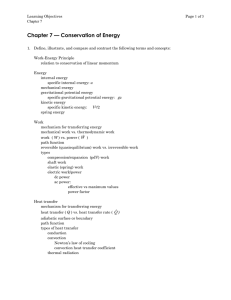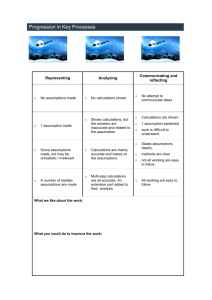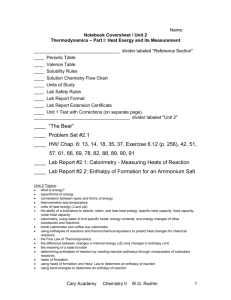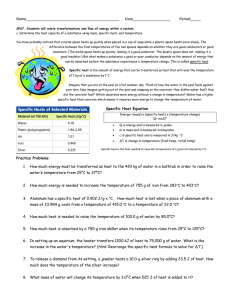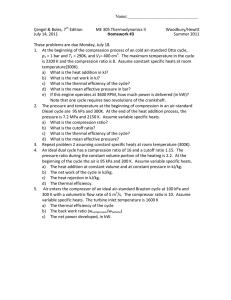u
advertisement
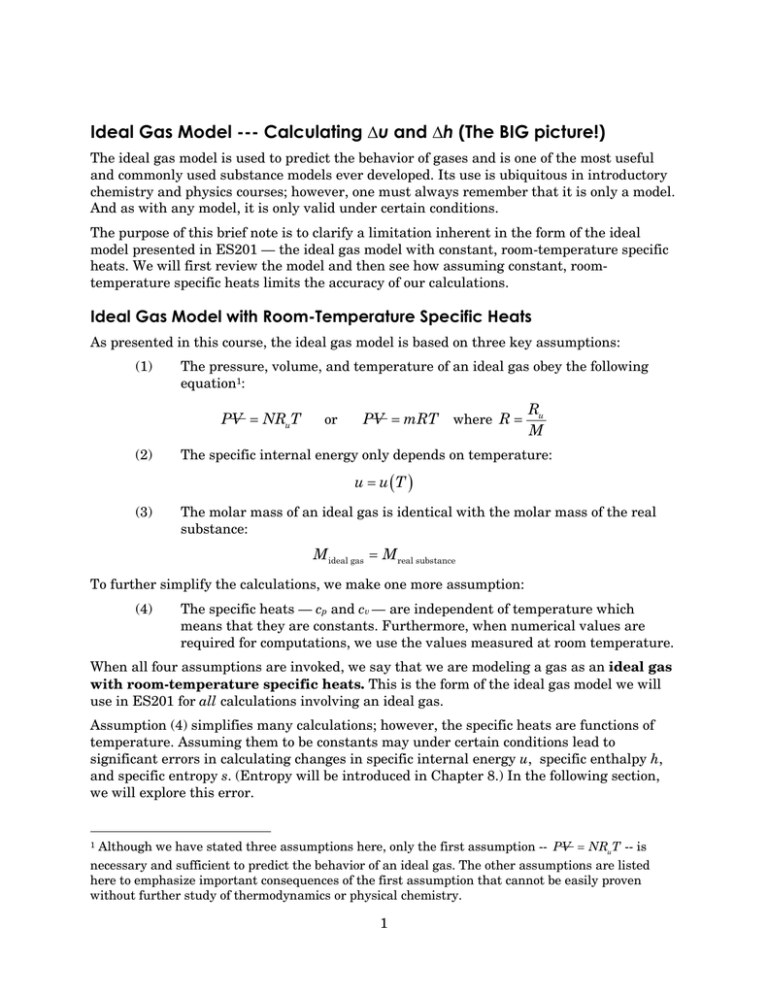
Ideal Gas Model --- Calculating ∆u and ∆h (The BIG picture!) The ideal gas model is used to predict the behavior of gases and is one of the most useful and commonly used substance models ever developed. Its use is ubiquitous in introductory chemistry and physics courses; however, one must always remember that it is only a model. And as with any model, it is only valid under certain conditions. The purpose of this brief note is to clarify a limitation inherent in the form of the ideal model presented in ES201 — the ideal gas model with constant, room-temperature specific heats. We will first review the model and then see how assuming constant, roomtemperature specific heats limits the accuracy of our calculations. Ideal Gas Model with Room-Temperature Specific Heats As presented in this course, the ideal gas model is based on three key assumptions: (1) The pressure, volume, and temperature of an ideal gas obey the following equation1: PV = NRuT (2) or PV = mRT where R = Ru M The specific internal energy only depends on temperature: u = u (T ) (3) The molar mass of an ideal gas is identical with the molar mass of the real substance: M ideal gas = M real substance To further simplify the calculations, we make one more assumption: (4) The specific heats — cp and cv — are independent of temperature which means that they are constants. Furthermore, when numerical values are required for computations, we use the values measured at room temperature. When all four assumptions are invoked, we say that we are modeling a gas as an ideal gas with room-temperature specific heats. This is the form of the ideal gas model we will use in ES201 for all calculations involving an ideal gas. Assumption (4) simplifies many calculations; however, the specific heats are functions of temperature. Assuming them to be constants may under certain conditions lead to significant errors in calculating changes in specific internal energy u, specific enthalpy h, and specific entropy s. (Entropy will be introduced in Chapter 8.) In the following section, we will explore this error. Although we have stated three assumptions here, only the first assumption -- PV = NRuT -- is necessary and sufficient to predict the behavior of an ideal gas. The other assumptions are listed here to emphasize important consequences of the first assumption that cannot be easily proven without further study of thermodynamics or physical chemistry. 1 1 How Bad is Assuming Constant, Room-Temperature Specific Heats We will first consider how this assumption influences how we calculate a change in specific internal energy, ∆u. By definition, the specific heat at constant volume cv is defined for all substances as the partial derivative of specific internal energy u with respect to temperature T with specific volume v held constant: ⎛ ∂u ⎞ cv = ⎜ ⎟ ⎝ ∂T ⎠v For an ideal gas, it can be shown (or assumed as in assumption 3 above) that the specific internal energy u is only a function of temperature: u = u(T). Combining this assumption with the definition for cv, we get an equation for the differential change in the specific internal energy of an ideal gas: ( ) du ⎛ ∂u ⎞ ⎡ ∂ ⎤ cv = ⎜ =⎢ u(T ) ⎥ = ⎟ ⎝ ∂T ⎠v ⎣ ∂T ⎦v dT ⇒ du = cv dT where cv is only a function of temperature T. Figure 1 shows the specific heat at constant volume cv as function of temperature for two gases, air and carbon dioxide. Table 1 provides numerical values for cv for four gases over a temperatures. 1.4 Cv [ kJ/(kg-K) ] 1.2 1 0.8 cv_air 0.6 cv_CO2 0.4 0.2 0 200 400 600 800 1000 1200 1400 1600 1800 2000 Temperature [K] Figure 1 – Variation of ideal gas specific heat with temperature 2 Table 1 — Ideal Gas Constant-Volume Specific Heat cv [ kJ/(kg-K) ] T (K) 300 400 500 600 700 800 900 1000 Air 0.7177 0.7262 0.7423 0.7638 0.7876 0.8114 0.8337 0.8538 O2 0.6618 0.6801 0.7140 0.7451 0.7713 0.7932 0.8116 0.8274 CO 0.7445 0.7478 0.7694 0.7952 0.8207 0.8445 0.8662 0.8858 CO2 0.6529 0.7494 0.8249 0.8857 0.9358 0.9775 1.013 1.042 While the specific heats are of interest in their own right, our real goal is to evaluate ∆u, the change in specific internal energy. To do this we integrate the differential change in the specific internal energy as follows: T2 T2 T1 T1 Δu = u2 − u1 = ∫ du = ∫ cvdT From calculus we know that any integral represents an area under a curve. Looking at Figure 2, we see that this integral is really just the area under the cv vs. T curve (the crosshatched area). To accurately evaluate the change in specific internal energy between T1 and T2, we must know how cv depends on temperature. This information is typically available as an equation, as a graph (Figure 1), or as a set of discrete values such as shown in Table 1. cv cv|T2 T2 Δu = ∫ cv(T )dT T1 cv|T1 cv|300 K Δu cv 300 K ⋅ (T2 − T1 ) 300 T1 T2 T (K) Figure 2 – Integral of du = cv dT 3 By assuming constant specific heats evaluated at room temperature (300K), we calculate the change in specific internal energy as follows: Δu = T2 ∫c( T1 v T) dT cv(300 K ) (T2 − T1 ) Referring back to Figure 2, we see that this integral is just the area inside the rectangular box outlined by a dark dashed line. The difference between the cross-hatched area and the dashed-line box area represents the error in using this approximation. If cv was constant, then this approximation would introduce no error. (The specific heats of monatomic gases like argon, helium, and neon are relative insensitive to temperature.) However, because cv changes with temperature for most gases, we need to investigate the error. Examining Figure 1, we can see that assuming constant cv appears to be a good assumption for air near 300K but a poor assumption for carbon dioxide. Table 2 shows the maximum error we in calculating ∆u if we assume constant, room-temperature values for cv. As one might expect, the farther you move away from room temperature (300 K) the larger the error. Table 2 — Maximum error in using constant, room temperature cv T (K) 300 400 500 600 700 800 900 1000 % Error = [∆uroom –∆uactual]/∆uactual Air O2 CO CO2 0.0 -1.2 -3.3 -6.0 -8.9 -11.5 -13.9 -15.9 0.0 -2.7 -7.3 -11.2 -14.2 -16.6 -18.5 -20.0 0.0 -0.4 -3.2 -6.4 -9.3 -11.8 -14.0 -16.0 0.0 -12.9 -20.9 -26.3 -30.2 -33.2 -35.5 -37.3 Errors of similar magnitude would also be found in calculating a change in specific enthalpy ∆h or a change in specific entropy ∆s. Thus our model — the ideal gas with room-temperature specific heats — will only accurately calculate ∆u, ∆h, and ∆s at temperatures near room temperature. If for instance we were to use this model to find out how much work is done by the piston in your car engine during the compression stroke our model could significantly underestimate the work required. However, this is a limitation we are willing to accept this quarter so that we can learn to use substance models in our energy and entropy calculations. Next quarter in ES202 – Fluid & Thermal Systems we will relax this restriction and learn how to more accurately calculate ∆u, ∆h, and ∆s for an ideal gas at any temperature. 4
